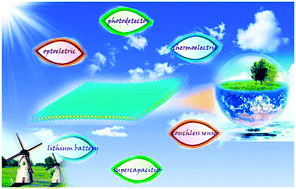28 Dec 13:54
by Jesse G. Kleingardner, Banu Kandemir and Kara L. Bren

Journal of the American Chemical Society
DOI: 10.1021/ja406818h

28 Dec 13:22
by Stenlid JH, Johansson AJ, Brinck T
Searching for the thermodynamic limit - a DFT study of the step-wise water oxidation of the bipyramidal Cu7 cluster.
Phys Chem Chem Phys. 2013 Dec 20;
Authors: Stenlid JH, Johansson AJ, Brinck T
Abstract
Oxidative degradation of copper in aqueous environments is a major concern in areas such as catalysis, electronics and construction engineering. A particular challenge is to systematically investigate the details of this process for non-ideal copper surfaces and particles under the conditions found in most real applications. To this end, we have used hybrid density functional theory to study the oxidation of a Cu7 cluster in water solution. Especially, the role of a large water coverage is explored. This has resulted in the conclusion that, under atmospheric H2 pressures, the thermodynamically most favored state of degradation is achieved upon the generation of four H2 molecules (i.e. Cu7 + 8H2O → Cu7(OH)8 + 4H2) in both condensed and gas phases. This state corresponds to an average oxidation state below Cu(i). The calculations suggest that the oxidation reaction is slow at ambient temperatures with the water dissociation as the rate-limiting step. Our findings are expected to have implication for, among other areas, the copper catalyzed water-gas shift reaction, and for the general understanding of copper corrosion in aqueous environments.
PMID: 24358468 [PubMed - as supplied by publisher]
28 Dec 13:13
by Haixia Li and Michael B. Hall

Journal of the American Chemical Society
DOI: 10.1021/ja410541v

24 Dec 11:29
by Xin Wang, Kui-Qing Peng, Ya Hu, Fu-Qiang Zhang, Bo Hu, Li Li, Meng Wang, Xiang-Min Meng and Shuit-Tong Lee

Nano Letters
DOI: 10.1021/nl402205f

24 Dec 11:28
by Lars Kohler, Nattawut Kaveevivitchai, Ruifa Zong and Randolph P. Thummel

Inorganic Chemistry
DOI: 10.1021/ic4022905

16 Dec 11:29
by Xavier Sala, Somnath Maji, Roger Bofill, Jordi García-Antón, Lluís Escriche and Antoni Llobet

Accounts of Chemical Research
DOI: 10.1021/ar400169p

16 Dec 11:21
by Zhang T, Wang C, Liu S, Wang JL, Lin W
A Biomimetic Copper Water Oxidation Catalyst with Low Overpotential.
J Am Chem Soc. 2013 Dec 10;
Authors: Zhang T, Wang C, Liu S, Wang JL, Lin W
Abstract
Simply mixing a Cu(II) salt and 6,6'-dihydroxy-2,2'-bipyridine (H2L) in a basic aqueous solution afforded a highly active water oxidation catalyst (WOC). Cyclic voltammetry of the solution at pH = 12-14 shows irreversible catalytic current with an onset potential of ~0.8 V vs. NHE. Catalytic oxygen evolution takes place in controlled potential electrolysis at a relatively low overpotential of 640 mV. Experimental and computational studies suggest that the L ligand participates in electron transfer processes to facilitate the oxidation of the Cu center to lead to an active WOC with low overpotential, akin to the use of the tyrosine radical by Photosystem II to oxidize the CaMn4 center for water oxidation.
PMID: 24325734 [PubMed - as supplied by publisher]
21 Nov 06:57
by Isidoro López, Mehmed Z. Ertem, Somnath Maji, Jordi Benet-Buchholz, Anke Keidel, Uwe Kuhlmann, Peter Hildebrandt, Christopher J. Cramer, Victor S. Batista, Antoni Llobet
Abstract
The homogeneous catalysis of water oxidation by transition-metal complexes has experienced spectacular development over the last five years. Practical energy-conversion schemes, however, require robust catalysts with large turnover frequencies. Herein we introduce a new oxidatively rugged and powerful dinuclear water-oxidation catalyst that is generated by self-assembly from a mononuclear catalyst during the catalytic process. Our kinetic and DFT computational analysis shows that two interconnected catalytic cycles coexist while the mononuclear system is slowly and irreversibly converted into the more stable dinuclear system: an extremely robust water-oxidation catalyst that does not decompose over extended periods of time.

In for the long haul: The transformation of a highly active mononuclear ruthenium–aqua water-oxidation catalyst into a dinuclear complex during oxygen-evolution catalysis led to the coexistence of two different catalytic cycles in solution (see picture; Ru pink, N blue, O red). The dinuclear species was much more robust than its mononuclear counterpart and remained an active catalyst for water oxidation for extended periods of time.
12 Nov 00:48
by Yang Qu, Wei Zhou, Honggang Fu
Abstract
New narrow band gap semiconductor cobalt titanate (CoTiO3) nanorods are fabricated via an ethylene glycol-mediated route and further calcination in air. The glycolate precursors and porous CoTiO3 nanorods are investigated in detail by using SEM, TEM, XRD, thermogravimetric, FTIR, and UV/Vis spectroscopy and N2 adsorption–desorption isotherm. The effect of calcining temperature is also studied, and 700 °C is found to be the optimal calcining temperature used to prepare porous CoTiO3 nanorods with high crystallinity and porosity as well as excellent photocatalytic performance in water oxidation under visible light irradiation. The highest oxygen production yield is up to 64.6 μmol h−1 without co-catalysts. The high photocatalytic activity for oxygen production is ascribed to the following reasons: 1) the large surface area, which favors absorption and offers more active sites, 2) the suitable narrow band gap, which can use more solar energy, and 3) the 1 D structure, which leads to good electron transport.

Let there be light! Porous cobalt titanate nanorods with a suitable narrow band gap, large surface area, and good crystallinity is found to be an excellent photocatalyst candidate for visible light-driven photocatalytic water oxidation.
16 Oct 16:00
by Edward I. Solomon, Kenneth M. Light, Lei V. Liu, Martin Srnec and Shaun D. Wong

Accounts of Chemical Research
DOI: 10.1021/ar400149m

15 Oct 00:56
by Debraj Chandra, Kenji Saito, Tatsuto Yui, Masayuki Yagi

Small mesopores are more efficient: A mesoprous oxide semiconductor (tungsten trioxide) having small mesopores was crystallized at high temperature (550 °C) by a simple one-step procedure. The highly crystalline mesoporous WO3 has an extremely high surface area which improves the visible-light-driven photoelectrochemical performance of water oxidation (see picture) relative to WO3 having interparticle mesopores.











